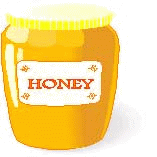

GARDENS (FRUITS, VEGETABLES)
The homesteaders planted gardens. They had to grow enough food to last them through the long winters.
They planted corn, cucumbers, beets,
beans, peas, onions, turnips, carrots, potatoes, cabbage, rhubarb and herbs. Herbs were
used for medicine and for flavoring when cooking (basil, parsley, oregano, rosemary,
sage, thyme, mustard, horseradish and dill).
Some vegetables from the garden were eaten fresh. Cucumbers, beets,
cabbage and onions were pickled
(in a mixture of water, vinegar, spices and salt) and kept in crocks.
Apples, herbs and vegetables (beans, peas, corn) were hung from the ceiling or near the fireplace and dried.
Some homesteaders grew strawberries,
raspberries and blueberries or picked wild berries.
MEAT AND FISH
Fresh meat was roasted on a spit, boiled in iron kettles or fried in cast iron skillets.
Salted, smoked or dried meat lasted a long time.
Sausage meat was meat that was chopped up into small pieces or ground up with a
meat grinder.
The fat was saved for lard,
and for making candles and soap.
COOKING IN THE FIREPLACE
Before settlers owned stoves, everything was cooked in the fireplace in iron cooking pots and kettles.
Some pots hung from a hook attached to an iron bar called a "swing crane".
Some pots had legs so the pots could be placed on the fire and hot coals.
Leftover food and peels were saved and fed to hogs and chickens.
BAKING BREAD, CHURNING BUTTER
Bread was baked in an oven that was built into the side of the fireplace. There
were also outdoor ovens for baking bread.
It took a lot of time to bake bread and churn butter
APPLES
Some settlers planted apple trees but it took a long time for the trees to grow and
produce apples.
The apples were packed in straw and kept in barrels. Some apples were pressed and
the juice was made into cider and vinegar. Apples were cooked to make applesauce and apple butter. Some apples were cut into slices, threaded on to strings or sticks and hung near the fire to dry. During the winter, the dried apples would be soaked in maple syrup, then baked into pies or puddings.
SUGAR AND HONEY
The pioneers collected honey made by honey bees and used it for baking and
sweetening foods.
They learned how to make syrup and sugar from the First Nations Peoples.
The Plains Cree and other groups used the sap from the Manitoba maple to make syrup and sugar.
ROOT CELLARS
Most settlers had root cellars for storing food.
The cellar was a cool dark place usually located under the kitchen. A trap door with a ladder
led down to the cellar. Sometimes the entrance to the cellar was from an outside
door. Cellars were also built into hillsides.
Fruits (apples) and vegetables (cabbage, potatoes, turnips, carrots) were kept in the cellar.
Smoked meats and fish were hung from the ceiling. Jars of canning were also stored. Other foods that needed to be kept cool were milk, butter, eggs and cheese.
The root cellar kept vegetables and other foods
just above freezing in the winter.
In the summer the cellar was cold enough to keep foods from spoiling.
Some homesteaders did not have root cellars. They dug pits (holes) for storing
vegetables (potatoes, turnips, carrots). The holes were filled
with straw so the food wouldn't freeze. Then the vegetables were buried so the food would last through the winter.
Only the essential foods such as flour, coffee, tea, molasses, and sometimes
sugar were bought at the store. Everything else came from the farm.

Fish was pickled, smoked, salted or dried
Meat and vegetables were made
into stews and soups.



J.Giannetta
2004
(updated 2011)